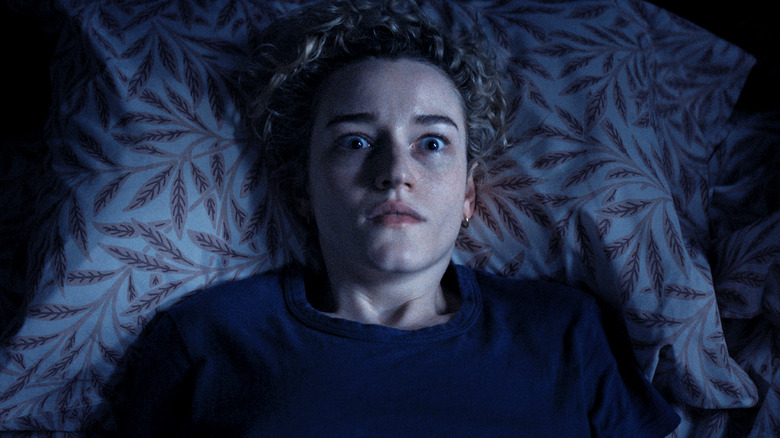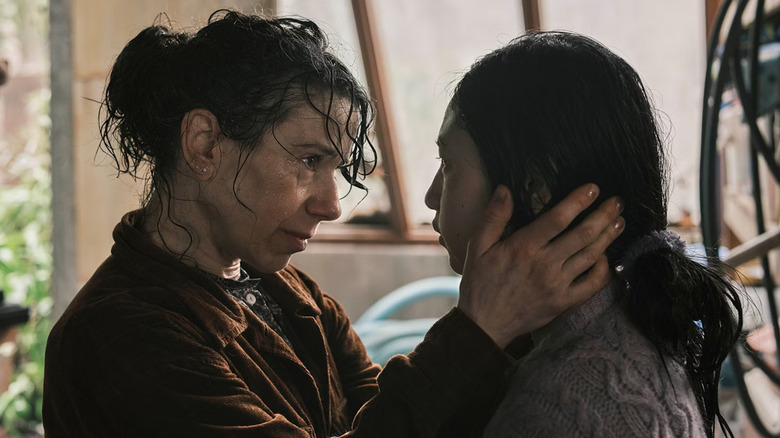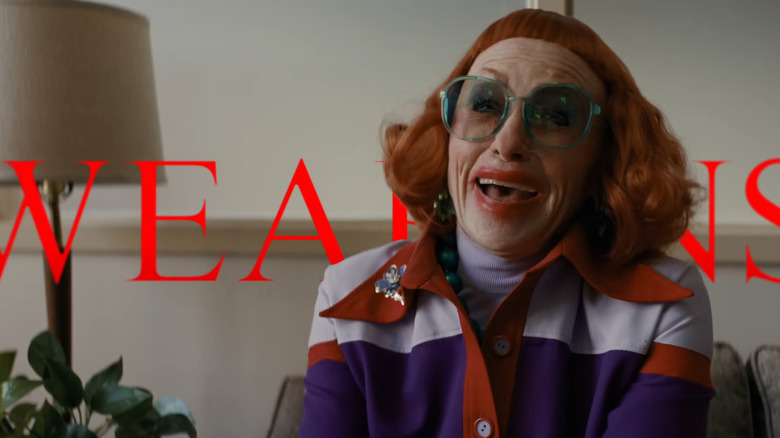Weapons Continues The Wild Comeback Of The Most Unexpected Horror Subgenre
This article contains spoilers for "Weapons."
Horror subgenres tend to go through periods of waxing and waning popularity. For example, slasher movies exploded in the early 1980s, died out a bit, came back strong in the late '90s, and so on. One of the more intriguing (and perhaps undersung) horror subgenres is that of the psycho-biddy film, also known as Hagsploitation. As with most all horror cinema subgenres, the trend wasn't created from whole cloth, but instead grew out of elements that had already been present in pop culture.
While it might appear that Hagsploitation is solely about a fear of (or at least an anxiety about) aging — and thus a fear of our own mortality — that's not quite accurate. In general, the psycho-biddy film, as that name suggests, puts an emphasis on elderly women rather than men. The fear that's exploited isn't one of aging or decrepitude, but rather the concept of an old woman acting as a wolf in sheep's clothing. This trend began more lightheartedly: Howard Hawks' 1944 adaptation of the popular stage play "Arsenic and Old Lace" plays the concept largely for laughs, but the tonal focus is the same. In that film, the most dangerous characters aren't the violent career criminals, but instead the two seemingly harmless elderly women. Decades later, in 1960, Alfred Hitchcock used the notion of a crazed, murderous old woman as a bait-and-switch feint in "Psycho."
In the same way that "Psycho" eventually birthed the slasher film, it could also be credited for unwittingly spawning the Hagsploitation trend. Two years later, Robert Aldrich's "What Ever Happened to Baby Jane?" became the subgenre's "Halloween," so to speak. That film kicked off a wave of movies which tried to repeat its formula: hire a big-name actress (or two), have her character suffer a tragic life that leads to mentally unstable murderousness, and let the character (if not the movie itself) be over-the-top in their melodrama.
While numerous horror movies have been made since the 1960s heyday of psycho-biddy films that contain elements of Hagsploitation, the subgenre laid low — until recently. For the past decade, psycho-biddies have made a very unexpected and wild comeback. The latest example, Zach Cregger's "Weapons," happens to be a stealth and sterling example of the subgenre.
The resurgence of psycho-biddy films
They say hindsight is 20/20, and looking back, it's almost too easy to pinpoint 2015 as the year when Hagsploitation came roaring back into horror cinema. While the pump had certainly been primed for its return ("The Taking of Deborah Logan" came out in 2014), both M. Night Shyamalan's "The Visit" and Robert Eggers' "The Witch" made enough of an impact to slowly kick off a new wave of psycho-biddy movies. "The Visit" combined concerns over the tragic horrors of aging with the more surreal, nightmarish fear of one's relatives not having your best interests at heart. "The Witch," meanwhile, obviously invokes classical phobias about black magic and witchcraft, and utilizes a mythological ancestor of the psycho-biddy to strike at the fear that your life may not be under your own control.
Since then, we've seen a large number of horror movies that either play around with Hagsploitation tropes or are clear examples of psycho-biddy films themselves. There's Ti West's "X," in which a fear of the horror of aging is combined with the unexpected threat that comes from a seemingly docile elderly woman. There's the first three features by Ari Aster: "Hereditary" contains a witchcraft plot and an increasingly unhinged Toni Collette, "Midsommar" has a moment of graphic sexualized elderly female nudity, and "Beau Is Afraid" is, ultimately, an offshoot psycho-biddy film. There's Zach Cregger's "Barbarian," in which a deformed, inbred old woman is the literal skeleton in the closet (or basement) that cannot be easily locked away and forgotten.
Over the past year, we've had a particularly steady stream of Hagsploitation films. There's "The Front Room," (made by Eggers' two brothers!), a movie about a mother-in-law from Hell who may also be practicing some form of witchcraft. There's Coralie Fargeat's "The Substance," a body horror parable that ends up seeing its protagonist transformed into what looks like an evil witch from a classic fairy tale. Then, just a few months ago, we received the Philippou brothers' "Bring Her Back," in which a middle-aged woman, driven mad with grief, attempts to violently manipulate the lives of the foster children under her care as part of a misguided black magic ritual. A mere two weeks ago (as of this writing), James DeMonaco's "The Home" was released, featuring a retirement home filled with malevolent elderly folks. With this week's release of "Weapons," it feels like our Hagsploitation diet is rapidly increasing.
How 'Weapons' fits into the Hagsploitation subgenre
"Weapons" is a film built around a central mystery: one random night in the town of Maybrook, Pennsylvania, all the students of one particular class left their homes of their own volition without explanation and went missing. Zach Cregger's movie is all about manipulation, and Cregger plays a long game with his characters as well as his audience. Eventually, the truth is revealed: the kids were supernaturally abducted via a spell cast by a witch who'd just moved into town, Gladys (Amy Madigan), whose nephew, Alex (Cary Christopher), was able to easily and surreptitiously collect personal objects of all the kids in his class for his aunt to use in her spell. The "how" of Gladys' plot is deliberately ambiguous, but the "why" is straightforward: Gladys is ill and dying, and she believes (either through faith or prior experience) that putting people under her thrall will allow her to heal. If anyone gets in her way or gets too close to exposing her secret, she turns them into a living weapon, a mindless slave who'll do whatever she commands.
In keeping with the film's theme of manipulation and tactic of misdirection, Cregger employs the psycho-biddy trope of danger coming from a place one would least suspect it. He doesn't necessarily do this for the audience; as soon as we meet Gladys, it's clear that something is off about this woman. Yet the citizens of Maybrook are certainly in the dark, as all of them (even Gladys' own family) dismiss the woman as harmless until it's too late. Gladys is not a sympathetic character — she certainly doesn't seem to display any regret about her actions toward others that is solely for her own benefit — yet in keeping with the villains of "The Visit," "X," and "The Front Room," Gladys's plight is understandable. Her ailing body is failing her obviously robust spirit. This allows Gladys to be a more classical Hagsploitation character, someone tragic who is also certainly mentally unstable and over-the-top, if her flamboyant choices in makeup and hair are anything to go by.
There have been criticisms of Hagsploitation over the years, with the most prominent one being that it's an inherently misogynistic subgenre. While that could certainly be argued, the fear that the subgenre seeks to elicit isn't a fear of women per se. Instead, it's a fear (and a guilt) regarding the way society tends to diminish and neglect people past a certain age, especially women. The psycho-biddy is a figure who refuses to be ignored, and their fatal flaw lies in how far they go to make themselves seen and have their needs met. Right now, the psycho-biddy seems to be getting seen a lot more than before, and they're not only providing us with new thrills, but are also forcing us to confront our own prejudices and blind spots.
"Weapons" is in theaters now.


